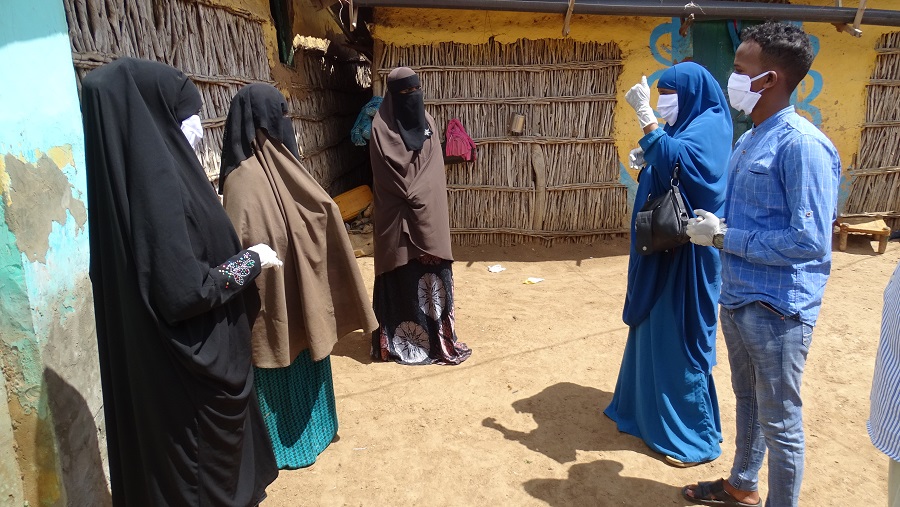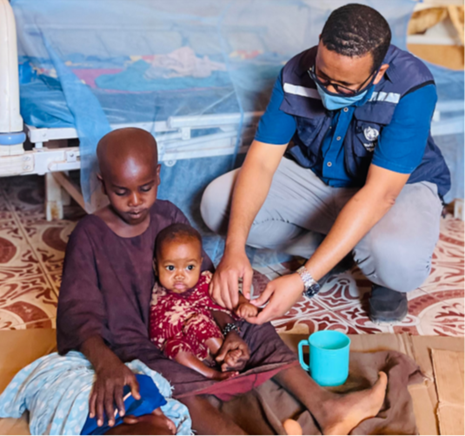 Community health workers explain methods of disease prevention. Credit: WHO/Somalia
Community health workers explain methods of disease prevention. Credit: WHO/Somalia
10 March 2022 – Somalia has witnessed intermittent drought over the last 3 decades. Each drought, and natural catastrophe, has brought with it a string of health consequences, magnified even further in a country with fragile and vulnerable health system.
CERF support delivering anticipatory action
To respond to an impending drought situation in Somalia during May to November in 2021, WHO provided timely support to the Ministry of Health and Human Services, with funding support from the Central Emergency Response Fund (CERF). Part of the support focused on the prevention and mitigation of the health consequences of drought through anticipatory action, while the other focused on delivering an urgent, swift response through the deployment of rapid response teams in affected districts.
Highlighting the progress made Dr Mamunur Rahman Malik, WHO Representative to Somalia and Head of Mission, said, “Our support prevented a major catastrophe when the country has still been reeling from the COVID-19 pandemic and its health system was yet to fully recover.” By considering Somalia’s previous experiences with drought, we were able to predict scenarios, prepare for, and respond to, difficult situations to save lives, and all the while offer essential primary health care services throughout the same efforts.”
Preventing and mitigating public health risks by anticipating effects of emergencies
In 2021, through the CERF anticipatory action project, WHO supported the ministries of health in Somaliland, Galmudug, Hirshabelle, Jubaland and Puntland to prevent and mitigate the public health risks of drought. In 11 high-risk districts earmarked by Somalia’s Health Cluster, WHO took measures to prevent the spread of diseases, reaching 163 266 people directly, 69 635 of whom were internally displaced people (IDPs) and 81 021 were women.
The project also enabled WHO to deploy health care workers, and rapid response teams, with a view to preventing disease spread and mitigating the health effects of drought at community levels. As a result, over 1100 outbreak alerts were detected and investigated in a timely manner. By enhancing surveillance for diseases, detecting, investigating and responding to alerts early, the country was able to avert larger outbreaks of diseases from cholera, measles and other epidemic disease, save lives and reduce the health consequences of drought.
The anticipatory action project has also supported scaling up of essential health care services, including treatment of severely malnourished children in nutrition stabilization centres across the states covered.
Through this support, WHO distributed medical supplies for treatment of severe acute malnutrition, cholera, malaria and pneumonia, thereby reaching 244 250 people, who had limited access to health services, with community outreach services.
Delivering a rapid response to public health challenges
As part of the second CERF-funded rapid response project, in 2021, in collaboration with state ministries of health, WHO deployed rapid response teams and community health workers to provide an urgent, essential health response for IDPs and host communities in 9 drought-affected districts in Somaliland, Jubaland and Puntland. Through this support, WHO directly reached 123 181 Somalis, 61 573 of whom were female.
Through this project, WHO deployed 324 community health workers who visited every household in drought-affected district to, report alerts to the rapid response teams for field investigation. These community health workers reported a total 2527 epidemic alerts, including for suspected measles, cholera, malaria and respiratory tract infections. The rapid response teams that were trained and deployed in 39 districts through this project investigated 1686 of these alerts triggered from the community health workers. These interventions prevented major outbreaks in drought-affected areas. In addition, WHO’s work helped to provide essential health care to over 491 206 beneficiaries.
Communities’ needs drive project activities
In places like riverine villages where Dahawo Muse Yusuf and her family live, these interventions support Somalis to be prepared for, and respond to, public health challenges.
Sitting upright on a bed at the Jowhar Regional Hospital, Dahawo explained how her village, Raqayle Umar Gudley, is affected every time the Shabelle River swells with floods, or runs dry through a drought. This is yet another time when Dahawo and her community have not been able to harvest crops since the last deyr rains failed, she adds grimly.
“We have no access to safe water and dig into the river bed to look for water sometimes,” said
20-year-old Dahawo. “I know of many people like me, from my village, who are suffering from diarrhoea due to drinking unsafe water. Once, an NGO – I can’t remember their name – gave us chlorine to clean water but that was just once.” When asked if she knew how to clean water, Dahawo chuckles and says they have not been able to discuss this issue at home, but that she would ask her husband, who is educated, to discuss with the community how to clean water to prevent diseases.
“People like Dahawo are suffering from diseases that can be prevented,” said Dr Mohamed Farah, the head clinician at the Jowhar Regional Hospital. “Many people also suffer from communicable diseases such as pneumonia, and acute watery diarrhoea, and several children are suffering from measles and severe acute malnutrition as the result of the drought. We are receiving patients from as far as Hiran and Jalaqsi. The situation is getting worse every day.”
Learning skills to prevent the spread of diseases
 WHO team visiting a stabilization centre in Baidoa, South West State, to provide technical support for integrated management of acute malnutrition, on 21 February 2022. Credit: WHO/ SomaliaThe two CERF-funded projects reached health care workers with different skill sets. In Belet Weyne, Nimca Kalil Mohamud, a nurse working at the Eljalle Health Centre offers women support to breastfeed their babies properly, and gives advice on family planning and nutrition.
WHO team visiting a stabilization centre in Baidoa, South West State, to provide technical support for integrated management of acute malnutrition, on 21 February 2022. Credit: WHO/ SomaliaThe two CERF-funded projects reached health care workers with different skill sets. In Belet Weyne, Nimca Kalil Mohamud, a nurse working at the Eljalle Health Centre offers women support to breastfeed their babies properly, and gives advice on family planning and nutrition.
She explained that she learnt a lot about the prevention of COVID-19 and the integrated management of childhood illnesses at a capacity-building session offered by WHO and the Government through CERF in 2021.
In addition to advancing skills and knowledge, such training also motivates health workers like her to do her job better, Nimca added.
Offering primary health care services to support affected communities
In continuing to ensure humanitarian aid reaches people affected by public health crises, WHO is supporting the Ministry of Health in Somalia in 2022 to ensure a rapid response intervention to mitigate the public health risks in some of the severest drought-affected districts of Galmudug and South West State.
Under these rapid response interventions supported by CERF, the project aims to increase communities’ access to primary health care services through fixed and outreach services, including the timely detection of and swift response to alerts of epidemic-prone diseases, as well as support risk communication, community engagement and health promotion activities. These efforts will continue to protect vulnerable populations from the adverse effects of drought.




